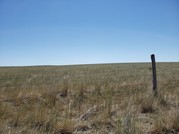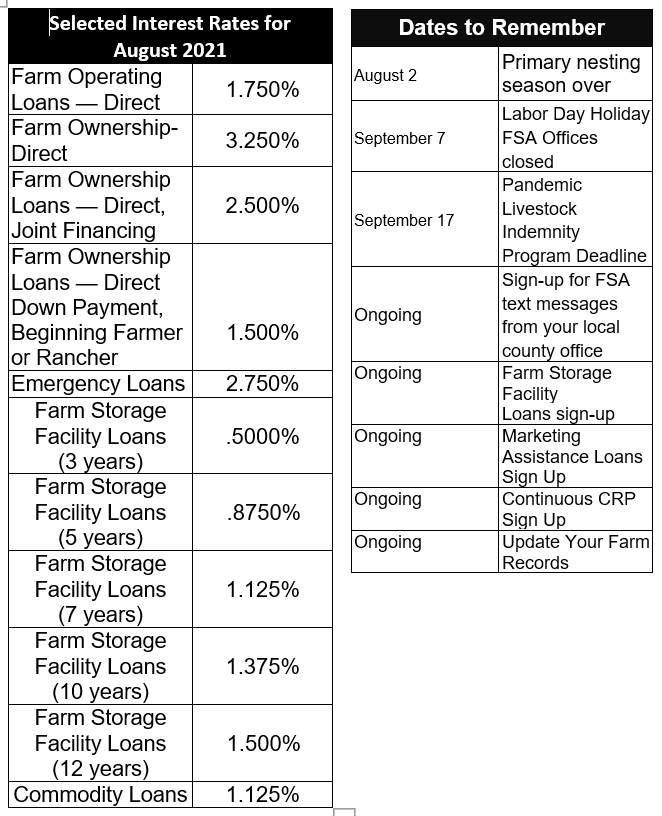In This Issue:

|
Greetings from the Illinois Farm Service Agency (FSA) ! Illinois FSA Service Centers are open, and we are accepting limited visitors by appointment only. Please be advised that all IL FSA Service Centers are adhering to the indoor masking requirements from the Centers for Disease Control and Prevention (CDC). As a result, all employees, contractors, and visitors must wear masks in ALL USDA buildings regardless of vaccination status. If visiting one of our Service Centers in-person is not an option for you, then rest assured our staff is prepared to assist with your customer service needs with signing and document sharing online.
Farmers and ranchers working with USDA’s FSA can now sign and share documents online in just a few clicks. By using Box or OneSpan, producers can digitally complete business transactions without leaving their homes or agricultural operations. Both services are free, secure, and available for multiple FSA programs.
FSA staff are available to help producers get started with Box and OneSpan through a few simple steps. Please visit farmers.gov/service-locator to find your local office and let Service Center staff know you are interested in signing and sharing documents through these new features. Please do not hesitate to contact your local Service Center for your customer service needs.
With reduced staffing and COVID protocols, it is strongly encouraged that you contact your local Service Center in advance to schedule an appointment.
A few months ago, we were encouraging our producers to schedule an appointment to report their planted acres, and now we are a few short weeks from starting harvest. IL FSA is also aware of some isolated severe weather events and understand adverse weather can create significant challenges and often result in catastrophic loss for agricultural producers.
For producers who have risk protection through Federal Crop Insurance or the Noninsured Crop Disaster Assistance Program (NAP), we want to remind you to report crop damage to your crop insurance agent or the local Farm Service Agency (FSA) office.
If you have crop insurance, contact your crop insurance agent within 72 hours of discovering damage and be sure to follow up in writing within 15 days. If you have NAP coverage, file a Notice of Loss (also called Form CCC-576) within 15 days of loss becoming apparent, except for hand-harvested crops, which should be reported within 72 hours.
FSA also offers disaster assistance programs, which is especially important to livestock, fruit and vegetable, specialty and perennial crop producers who have fewer risk management options.
First, the Livestock Indemnity Program (LIP) and Emergency Assistance for Livestock, Honeybee and Farm-raised Fish Program (ELAP) reimburses producers for a portion of the value of livestock, poultry and other animals that died as a result of a qualifying natural disaster event or for loss of grazing acres, feed and forage. And, the Livestock Forage Disaster Program (LFP) provides assistance to producers of grazed forage crop acres that have suffered crop loss due to a qualifying drought. Livestock producers suffering the impacts of drought can also request Emergency Haying and Grazing on Conservation Reserve Program (CRP) acres.
For more information on these programs or other programs offered by FSA, please contact your local Service Center. In closing, I want to thank our dedicated employees and resilient Illinois Farmers for their continued patience and understanding during these difficult times.
Sincerely,
Dan Puccetti
Acting State Executive Director
|
|

The Farm Service Agency (FSA) has several loan programs to help you start or continue an agriculture production. Farm ownership and operating loans are available.
While all qualified producers are eligible to apply for these loan programs, FSA has provided priority funding for members of targeted underserved applicants.
A targeted underserved applicant is one of a group whose members have been subjected to racial, ethnic or gender prejudice because of his or her identity as members of the group without regard to his or her individual qualities.
For purposes of this program, targeted underserved groups are women, African Americans, American Indians, Alaskan Natives, Hispanics, Asian Americans and Pacific Islanders.
FSA loans are only available to applicants who meet all the eligibility requirements and are unable to obtain the needed credit elsewhere.
Contact your local FSA County Office Service Center or visit fsa.usda.gov/farmloans for more information.
|

|
Options Help More Beginning, Small and Urban Producers Gain Access to Credit
Producers can apply for a streamlined version of USDA guaranteed loans, which are tailored for smaller scale farms and urban producers EZ Guarantee Loans use a simplified application process to help beginning, small, underserved, and family farmers and ranchers apply for loans of up to $100,000 from USDA-approved lenders to purchase farmland or finance agricultural operations.
A new category of lenders will join traditional lenders, such as banks and credit unions, in offering USDA EZ Guarantee Loans. Microlenders, which include Community Development Financial Institutions and Rural Rehabilitation Corporations, will be able to offer their customers up to $50,000 of EZ Guaranteed Loans, helping to reach urban areas and underserved producers. Banks, credit unions and other traditional USDA-approved lenders, can offer customers up to $100,000 to help with agricultural operation costs.
EZ Guarantee Loans offer low interest rates and terms up to seven years for financing operating expenses and 40 years for financing the purchase of farm real estate. USDA-approved lenders can issue these loans with the Farm Service Agency (FSA) guaranteeing the loan up to 95 percent.
For more information about the available types of FSA farm loans, contact your local county USDA Service Center or visit fsa.usda.gov/farmloans.
|
|

USDA is authorizing emergency procedures to help agricultural producers impacted by extreme drought conditions. USDA’s Risk Management Agency (RMA) is working with crop insurance companies to streamline and accelerate the adjustment of losses and issuance of indemnity payments to crop insurance policyholders in impacted areas.
These new crop insurance flexibilities are part of USDA’s broader response to help producers impacted by drought, in the West, Northern Great Plains, Caribbean and other areas.
Emergency procedures allow insurance companies to accept delayed notices of loss in certain situations, streamline paperwork, and reduce the number of required representative samples when damage is consistent. These flexibilities will reduce burdens on both insurance companies and producers to help mitigate drought effects.
Producers should contact their crop insurance agent as soon as they notice damage. The insurance company must have an opportunity to inspect the crop before the producer puts their crop acres to another use. If the company cannot make an accurate appraisal, or the producer disagrees with the appraisal at the time the acreage is to be destroyed or no longer cared for, the insurance company and producer can determine representative sample areas to be left intact and maintained for future appraisal purposes. Once an insured crop has been appraised and released, or representative strips have been authorized for later appraisal, the producer may cut the crop for silage, destroy it or take any other action on the land including planting a cover crop.
Additional information on these emergency procedures is available on RMA’s Crop Insurance and Drought Damaged Crop webpage. Crop insurance is sold and delivered solely through private crop insurance agents. A list of crop insurance agents is available at all USDA Service Centers and online at the RMA Agent Locator. Learn more about crop insurance and the modern farm safety net at rma.usda.gov.
|
The Noninsured Crop Disaster Assistance Program (NAP) provides financial assistance to you for crops that aren’t eligible for crop insurance to protect against lower yields or crops unable to be planted due to natural disasters including freeze, hail, excessive moisture, excessive wind or hurricanes, flood, excessive heat and qualifying drought (includes native grass for grazing), among others.
In order to participate, you must obtain NAP coverage for the crop year by the applicable deadline using form CCC-471 “Application for Coverage” and pay the service fee. Application closing dates vary by crop. Producers are also required to submit an acceptable crop acreage report. Additionally, NAP participants must provide:
- The quantity of all harvested production of the crop in which the producer held an interest during the crop year
- The disposition of the harvested crop, such as whether it is marketable, unmarketable, salvaged or used differently than intended
- Acceptable crop production records (when requested by FSA)
Producers who fail to report acreage and production information for NAP-covered crops could see reduced or zero NAP assistance. These reports are used to calculate the approved yield.
If your NAP-covered crops are affected by a natural disaster, notify your FSA office by completing Part B of form CCC-576 “Notice of Loss and Application for Payment.” This must be completed within 15 calendar days of the occurrence of the disaster or when losses become apparent or 15 days of the final harvest date. For hand-harvested crops and certain perishable crops, you must notify FSA within 72 hours of when a loss becomes apparent.
To receive benefits, you must also complete Parts D, E, F and G of the CCC-576 “Notice of Loss and Application for Payment” within 60 days of the last day of coverage for the crop year for any NAP covered crops. The CCC-576 requires acceptable appraisal information. Producers must provide evidence of production and note whether the crop was marketable, unmarketable, salvaged or used differently than intended.
Eligible crops must be commercially produced agricultural commodities for which crop insurance is not available, including perennial grass forage and grazing crops, fruits, vegetables, mushrooms, floriculture, ornamental nursery, aquaculture, turf grass, ginseng, honey, syrup, bioenergy, and industrial crops.
For more information on NAP, contact your local County USDA Service Center or visit fsa.usda.gov/nap.
The Farm Service Agency (FSA), Natural Resources Conservation Service (NRCS) and Risk Management Agency (RMA) worked together to develop consistent, simple and a flexible policy for cover crop practices.
Cover crops, such as grasses, legumes and forbs, can be planted: with no subsequent crop planted, before a subsequent crop, after prevented planting acreage, after a planted crop, or into a standing crop.
Termination:
The cover crop termination guidelines provide the timeline for terminating cover crops, are based on zones and apply to non-irrigated cropland. To view the zones and additional guidelines visit nrcs.usda.gov/wps/portal/nrcs/main/national/landuse/crops/ and click “Cover Crop Termination Guidelines.”
The cover crop may be terminated by natural causes, such as frost, or intentionally terminated through chemical application, crimping, rolling, tillage or cutting. A cover crop managed and terminated according to NRCS Cover Crop Termination Guidelines is not considered a crop for crop insurance purposes.
Reporting:
The intended use of cover only will be used to report cover crops. This includes crops
that were terminated by tillage and reported with an intended use code of green manure. An FSA policy change will allow cover crops to be hayed and grazed. Program eligibility for the cover crop that is being hayed or grazed will be determined by each specific program.
If the crop reported as cover only is harvested for any use other than forage or grazing and is not terminated properly, then that crop will no longer be considered a cover crop.
Crops reported with an intended use of cover only will not count toward the total cropland on the farm. In these situations, a subsequent crop will be reported to account for all cropland on the farm.
The U.S. Department of Agriculture (USDA) is providing up to $200 million to provide relief to timber harvesting and timber hauling businesses that have experienced losses due to COVID-19 as part of USDA’s Pandemic Assistance for Producers initiative. Loggers and truckers can apply for assistance through USDA’s Farm Service Agency (FSA) July 22 through Oct. 15, 2021. The Pandemic Assistance for Timber Harvesters and Haulers program (PATHH) is administered by FSA in partnership with the U.S. Forest Service.
The Consolidated Appropriations Act, 2021, authorized this critical assistance for the timber industry. Timber harvesting and hauling businesses that have experienced a gross revenue loss of at least 10% during the period of January 1 and December 1, 2020, compared to the period of January. 1 and December 1, 2019, are encouraged to apply.
Program Details
To be eligible for payments, individuals or legal entities must be a timber harvesting or timber hauling business where 50% or more of its gross revenue is derived from one or more of the following:
- Cutting timber.
- Transporting timber.
- Processing of wood on-site on the forest land (chipping, grinding, converting to biochar, cutting to smaller lengths, etc.).
Payments will be based on the applicant’s gross revenue received from January 1, 2019, through December1, 2019, minus gross revenue received from January1, 2020, through December 1, 2020, multiplied by 80%. FSA will issue an initial payment equal to the lesser of the calculated payment amount or $2,000 as applications are approved. A second payment will be made after the signup period has ended based upon remaining PATHH funds.
The maximum amount that a person or legal entity may receive directly is $125,000.
Applying for Assistance
Loggers and truckers can apply for PATHH beginning on July 22 by completing form FSA-1118, Pandemic Assistance for Timber Harvesters and Haulers Program application, and certifying to their gross revenue for 2019 and 2020 on the application. Additional documentation may be required. Visit farmers.gov/pathh for more information on how to apply.
Applications can be submitted to the FSA office at any USDA Service Center nationwide by mail, fax, hand delivery, or via electronic means. To find a local FSA office, loggers and truckers can visit farmers.gov/service-locator. They can also call 877-508-8364 to speak directly with a USDA employee ready to offer assistance.
FSA’s Farm Storage Facility Loan (FSFL) program provides low-interest financing to producers to build or upgrade storage facilities and to purchase portable (new or used) structures, equipment and storage and handling trucks.
The low-interest funds can be used to build or upgrade permanent facilities to store commodities. Eligible commodities include corn, grain sorghum, rice, soybeans, oats, peanuts, wheat, barley, minor oilseeds harvested as whole grain, pulse crops (lentils, chickpeas and dry peas), hay, honey, renewable biomass, fruits, nuts and vegetables for cold storage facilities, floriculture, hops, maple sap, rye, milk, cheese, butter, yogurt, meat and poultry (unprocessed), eggs, and aquaculture (excluding systems that maintain live animals through uptake and discharge of water). Qualified facilities include grain bins, hay barns and cold storage facilities for eligible commodities.
Loans up to $50,000 can be secured by a promissory note/security agreement and loans between $50,000 and $100,000 may require additional security. Loans exceeding $100,000 require additional security.
Producers do not need to demonstrate the lack of commercial credit availability to apply. The loans are designed to assist a diverse range of farming operations, including small and mid-sized businesses, new farmers, operations supplying local food and farmers markets, non-traditional farm products, and underserved producers.
To learn more about the FSA Farm Storage Facility Loan, visit www.fsa.usda.gov/pricesupport or contact your local FSA county office. To find your local FSA county office, visit http://offices.usda.gov.
Livestock and poultry producers who suffered losses during the pandemic due to insufficient access to processing can apply for assistance for those losses and the cost of depopulation and disposal of the animals. The U.S. Department of Agriculture (USDA) Secretary Vilsack announced the Pandemic Livestock Indemnity Program (PLIP) in [recorded] remarks at the National Pork Industry Conference in Wisconsin Dells, WI. The announcement is part of USDA’s Pandemic Assistance for Producers initiative. Livestock and poultry producers can apply for assistance through USDA’s Farm Service Agency (FSA) July 20 through Sept. 17, 2021.
The Consolidated Appropriations Act, 2021, authorized payments to producers for losses of livestock or poultry depopulated from March 1, 2020 through December 26, 2020, due to insufficient processing access as a result of the pandemic. PLIP payments will be based on 80% of the fair market value of the livestock and poultry and for the cost of depopulation and disposal of the animal. Eligible livestock and poultry include swine, chickens and turkeys.
PLIP Program Details
Eligible livestock must have been depopulated from March 1, 2020, through December 26, 2020, due to insufficient processing access as a result of the pandemic. Livestock must have been physically located in the U.S. or a territory of the U.S. at the time of depopulation.
Eligible livestock owners include persons or legal entities who, as of the day the eligible livestock was depopulated, had legal ownership of the livestock. Packers, live poultry dealers and contract growers are not eligible for PLIP.
PLIP payments compensate participants for 80% of both the loss of the eligible livestock or poultry and for the cost of depopulation and disposal based on a single payment rate per head. PLIP payments will be calculated by multiplying the number of head of eligible livestock or poultry by the payment rate per head, and then subtracting the amount of any payments the eligible livestock or poultry owner has received for disposal of the livestock or poultry under the Natural Resources Conservation Service (NRCS) Environmental Quality Incentives Program (EQIP) or a state program. The payments will also be reduced by any Coronavirus Food Assistance Program (CFAP 1 and 2) payments paid on the same inventory of swine that were depopulated.
There is no per person or legal entity payment limitation on PLIP payments. To be eligible for payments, a person or legal entity must have an average adjusted gross income (AGI) of less than $900,000 for tax years 2016, 2017 and 2018.
Applying for Assistance
Eligible livestock and poultry producers can apply for PLIP starting July 20, 2021, by completing the FSA-620, Pandemic Livestock Indemnity Program application, and submitting it to any FSA county office. Additional documentation may be required. Visit farmers.gov/plip for a copy of the Notice of Funding Availability and more information on how to apply.
Applications can be submitted to the FSA office at any USDA Service Center nationwide by mail, fax, hand delivery or via electronic means. To find your local FSA office, visit farmers.gov/service-locator. Livestock and poultry producers can also call 877-508-8364 to speak directly with a USDA employee ready to offer assistance.
The National Environmental Policy Act (NEPA) requires Federal agencies to consider all potential environmental impacts for federally-funded projects before the project is approved.
For all Farm Service Agency (FSA) programs, an environmental review must be completed before actions are approved, such as site preparation or ground disturbance. These programs include, but are not limited to, the Emergency Conservation Program (ECP), Farm Storage Facility Loan (FSFL) program and farm loans. If project implementation begins before FSA has completed an environmental review, the request will be denied. Although there are exceptions regarding the Stafford Act and emergencies, it’s important to wait until you receive written approval of your project proposal before starting any actions.
Applications cannot be approved until FSA has copies of all permits and plans. Contact your local FSA office early in your planning process to determine what level of environmental review is required for your program application so that it can be completed timely.
FSA is cleaning up our producer record database and needs your help. Please report any changes of address, zip code, phone number, email address or an incorrect name or business name on file to our office. You should also report changes in your farm operation, like the addition of a farm by lease or purchase. You should also report any changes to your operation in which you reorganize to form a Trust, LLC or other legal entity.
FSA and NRCS program participants are required to promptly report changes in their farming operation to the County Committee in writing and to update their Farm Operating Plan on form CCC-902.
If you have any updates or corrections, please call your local FSA office to update your records.
Farm Service Agency (FSA) program payments are issued electronically into your bank account. In order to receive timely payments, you need to notify your FSA servicing office if you close your account or if your bank information is changed for any reason (such as your financial institution merging or being purchased). Payments can be delayed if FSA is not notified of changes to account and bank routing numbers.
For some programs, payments are not made until the following year. For example, payments for crop year 2019 through the Agriculture Risk Coverage and Price Loss Coverage program aren’t paid until 2020. If the bank account was closed due to the death of an individual or dissolution of an entity or partnership before the payment was issued, please notify your local FSA office as soon as possible to claim your payment.

|